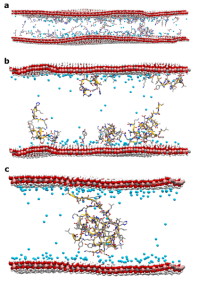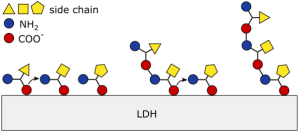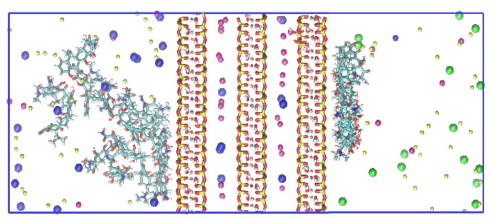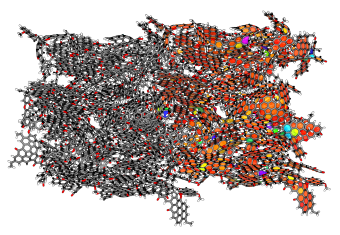Research

Our research focus is on the use and development of molecular models and computational techniques for the study of dynamic processes involving minerals, materials and interactions at their interfaces.
The group and our collaborators have a very unique multidisciplinary background, bringing together knowledge from theoretical and experimental chemistry, material and environmental sciences, geosciences and astrobiology. We aspire for our work to foster a step-change in computational modelling, ensuring that the work we do are of direct benefit to our society.
The applications of our research are vast, from abiogenetic origins of life, biosignature identification, soil and water pollution remediation, nuclear waste storage, enhanced oil recovery and fuel additives, all done with a pinch of software development.
OUR AREAS of research
Origins of Life

The origins of life have been the subject of much research, but fundamental questions still remain unanswered. We are interested on the surface-supported the abiogenetic formation of proto-biomolecules in early Earth and extraterrestrial conditions, as well as the preservation of potential bosignatures.
Pollution Remediation

The rise of densely populated environments brings new challenges to our society, one of many is the management and disposal of increasingly diverse pollutants. With our work we aim to identify the key properties making naturally occurring materials capable of adsorbing small organic pollutants.
BIOCHAR MATERIALS

Biochar is a remarkable material! Made from pyrolysis of biomass, byproduct of human waste, they have been used for soil amendment, carbon deposition and, more recently for sequestration of pollutants. With a poorly defined structure and featuring large variety of chemical structures and functional groups, creating a representative molecular model of biochar is not a simple task. We are working on developing these models to become available for the biochar research community.
Enhanced Oil Recovery

Organic molecules in the hydrated pore of kaolinite clay mineral
EOR has become commonplace in order to maximise oil field production. Our work elucidates the mechanisms behind this process with series of clay – oil simulations.
Group
CURRENT Members


Rosie Wood – E4 DTP PhD Student (since 2020)
I am a PhD student working on the molecular modelling of biochars. The goal of my research is to better understand the interfacial interactions of biochars and ultimately offer insights into how to improve their performance as adsorbents in water treatment. I did my undergraduate degree in chemistry at the University of Bristol and, as part of the E4 DTP, I will be taking courses across many different areas of environmental science.

Hannah Pollak – PhD Student (since 2021)
In my PhD project I am studying interactions between clays and organic pollutants such as pharmaceuticals. I am using molecular modelling techniques in order to gain atomic-level understanding about retention and release of contaminants by minerals in soils. These insights should enable the design of effective materials to be used in drug pollution remediation.
During my bachelor’s studies in chemistry, and my master’s studies in theoretical chemistry and computational modelling I focused on the experimental and theoretical study of biological systems. I believe that my expertise in these fields provides me with a good foundation for my current research.

Audrey Ngambia – PhD student (since 2021)
Audrey was awarder prestigious Edinburgh Doctoral College Scholarship to do her PhD on modelling of biochars, and is co-supervised by Prof Ondrej Masek at the UK Biochar Research Center.

Sarah Stewart – PhD student (since 2023)
Having worked with us for her internship in the summer of 2021, Sarah became interested in using and developing molecular modelling for astrobiology research. She then secured a competitive E4 DTP for her project Understanding Preservation of Potential Biosignatures by Martian Soils, co-supervised by Dr Sean McMahon and Prof Charles Cockell at the UK Center for Astrobiology.

Jonathan Reid – PhD student (since 2023)
Jon’s PhD focuses on connecting molecular modelling and experiment to enable the Understanding interactions between minerals and small biopolymers under extreme conditions. Jon is co-supervised by Dr Sean McMahon and Prof Charles Cockell at the UK Center for Astrobiology.

Xunyi Zhu – Bachelors project student (2023/24)
Xunyi is in the last year of his undergraduate studies. His current research focus is on simulating the process of amino acids binding to clay surfaces to form peptides, using computational chemistry tools.

Rixin Zhao – visiting PhD student (2023)
Rixin is a visiting PhD student from the School of Geosciences at China University of Petroleum (East China), supervised by Prof. Shuangfang Lu. Rixin was awarded the prestigious CSC Scholarship to spend a year in the UK between Durham University, where he is carrying out E-SEM and AFM studies of shales supervised by Prof. Chris Greenwell, and our group at the University of Edinburgh, to work on the molecular simulations of organic-clay interactions.

Anar Nuruzada – visiting PhD student (2023)
Rixin is a visiting PhD student from the School of Geosciences at China University of Petroleum (East China), supervised by Prof. Shuangfang Lu. Rixin was awarded the prestigious CSC Scholarship to spend a year in the UK between Durham University, where he is carrying out E-SEM and AFM studies of shales supervised by Prof. Chris Greenwell, and our group at the University of Edinburgh, to work on the molecular simulations of organic-clay interactions.
Joining the Group
If you are interested in joining the group as a PostDoc, PhD, Masters or an Intern for more details and funding opportunities see here.
Continue reading “Group”News
2 Ph.D. positions via e4 DTP
We have 2 projects under E4 DTP, both with a deadline on the 4th of Jan 2024. Please follow the links to apply. 1. Ultracool Chemistry in Noctilucent Clouds Apply here. 2. Application of high-throughput simulations for informed design of optimised biochars for sequential treatment of emerging contaminants Apply here.
PhD position in Astrobiology
Understanding interactions between minerals and small biopolymers under extreme conditions The project combines computational screening and wet-lab experiments to develop a comprehensive understanding of the interactions between silicate minerals and small biologically-relevant molecules, such as amino acids, peptides, peptoids and proteins. Our goal is to study the stability of these organic molecules and their mineral-enabled … Continue reading PhD position in Astrobiology

